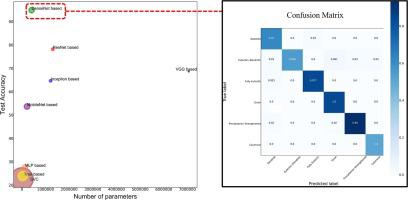Computational Materials Science ( IF 3.1 ) Pub Date : 2021-08-28 , DOI: 10.1016/j.commatsci.2021.110815 Surya Prakash Mishra 1 , M.R. Rahul 1

|
The properties and processing of materials depend on the microstructure at various stages. Identifying the microstructure is essential for the accelerated development of advanced materials and Material Informatics initiatives. In the current study Convolutional Neural Network (CNN) models such as ResNet, VGG, DenseNet, Inception based, MobileNet based, SVC, Tree based, MLP based are trained and compared for microstructure classification. The models are developed with fewer parameters by decreasing the depth and width of the network. The model based on DenseNet shows high testing, training, and validation accuracy with an optimum number of parameters. The developed model based on DenseNet has a total number of parameters of 421674, including 10,930 non-trainable parameters and 4 Dense blocks, 3 Transition blocks, and the fully connected network. The current model achieved a training accuracy of 97.45%, validation accuracy of 96.26%, and testing accuracy of 94.89%. The developed model is used for classifying the microstructure of high entropy alloys, and results show a good agreement. These state-of-the-art models will accelerate the material development and Material Informatics initiatives.
中文翻译:

一种用于加速材料科学微观结构识别的新型深度学习架构的比较研究和开发
材料的性能和加工过程取决于各个阶段的微观结构。识别微观结构对于加快先进材料和材料信息学计划的发展至关重要。在目前的研究中,卷积神经网络 (CNN) 模型如 ResNet、VGG、DenseNet、基于 Inception、基于 MobileNet、SVC、基于树、基于 MLP 的模型被训练和比较以进行微观结构分类。通过减少网络的深度和宽度,以更少的参数开发模型。基于 DenseNet 的模型显示出具有最佳参数数量的高测试、训练和验证准确性。基于 DenseNet 开发的模型共有 421674 个参数,包括 10930 个不可训练参数和 4 个 Dense 块、3 个 Transition 块和全连接网络。当前模型达到了97.45%的训练准确率、96.26%的验证准确率和94.89%的测试准确率。所开发的模型用于对高熵合金的微观结构进行分类,结果显示出良好的一致性。这些最先进的模型将加速材料开发和材料信息学计划。











































 京公网安备 11010802027423号
京公网安备 11010802027423号